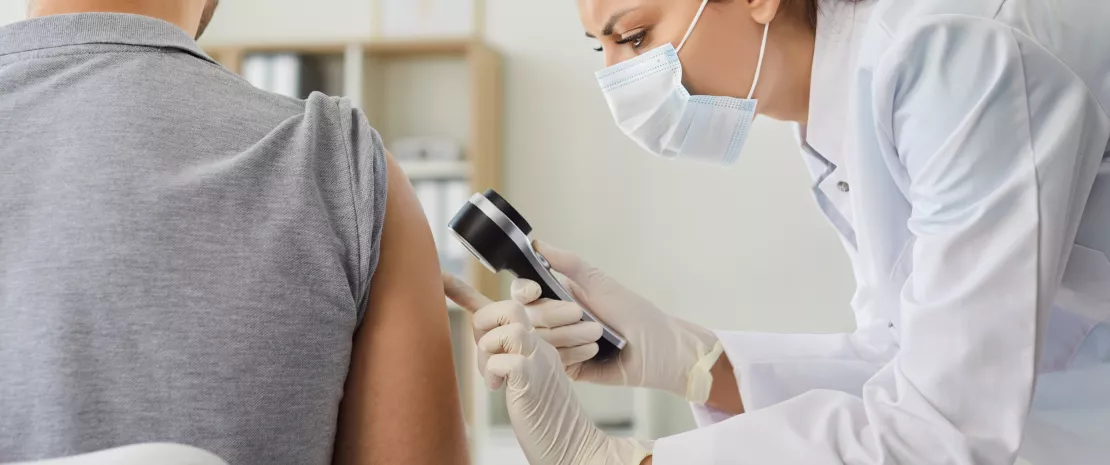Feel good in your skin... and your skin microbiota
Could the secret to our well-being be somewhere on our skin? A pioneering British study suggests a link between the skin microbiota and emotional balance: people with higher levels of Cutibacterium are less stressed and happier.
- Learn all about microbiota
- Microbiota and related conditions
- Act on your microbiota
- Publications
- About the Institute
Healthcare professionals section
Find here your dedicated section
Sources
This article is based on scientific information

About this article
Rather than “feel good in your skin”, should we be saying “feel good in your skin microbiota ”?
So suggests a British study, linking psychological well-being to the microorganisms living on our skin, specifically the skin of the face, scalp, forearms, and armpits, based on a study of 53 Britons with an average age of 63. This research highlights a system of interactions between the skin and the brain, echoing the now familiar dynamics of the gut-brain axis.
More Cutibacterium, more well-being?
The study shows for the first time an increased abundance of certain bacterial genera in those who feel the best in their skin, both in terms of general well-being and the well-being of the skin area in question. The skin bacterium most common to Britons who feel the most comfortable in their bodies is (sidenote: Cutibacterium A bacterial genus whose classification has been significantly revised in recent years (until 2016, it was known as Propionibacterium). The genus includes several species, including the infamous C. acnes (an opportunistic pathogen involved in acne and infections of breast implants, shoulders, etc.), as well as C. avidum, C. granulosum, C. namnetense, and C. humerusii Ahle CM, Feidenhansl C, Brüggemann H. Cutibacterium acnes. Trends Microbiol. 2023 Apr;31(4):419-420. ; CTCB ) . Do you have plenty of it on your face? Then you must be fairly stress-free. If your armpits are teeming with it, your mood is likely to be good and your stress levels low. Conversely, a lower abundance of Cutibacterium may contribute to disorders such as stress, anxiety, or depression.
This is somewhat surprising, since Cutibacterium is usually associated with C. acnes and the puberty nightmares that come with it, rather than elderly Britons enjoying their golden years. This bacterium could also promote positive skin health by inhibiting pathogens and regulating skin acidity, thanks to its ability to convert sebum into free fatty acids.
Effects of Cutibacterium according to body area
- Face: people who have more Cutibacterium on their face report lower stress.
- Armpits: a higher presence of this bacterium is linked to a better mood and reduced stress.
- Forearms: more Cutibacterium on the forearms is associated with greater satisfaction with one’s skin.
Cause or effect?
The central question is, as always, whether the presence of Cutibacterium is a cause or effect of well-being. In other words, does the presence of Cutibacterium make us happy, or does a cheerful disposition attract Cutibacterium to the skin? Or could it be a third factor common to both, such as lifestyle, exercise, or diet?
At present, we can’t say. We do know that the skin and its microbiota act as a protective barrier for the body, inhibiting pathogens, and thus providing security and peace of mind. Conversely, it has been shown that stress, anxiety, and depression can impact our skin, leading to skin disorders such as eczema (or atopic dermatitis), psoriasis, acne, and underarm odor.
17% Only 17% of those surveyed said they knew exactly what the skin microbiota is. ²
We’ve heard of the gut-brain axis, and now we know there’s a bidirectional skin-brain axis as well, with the former influencing the latter and vice versa. For the first time, a link has been found between skin microbiota and psychological well-being. This should encourage (sidenote: Psychodermatology Psychodermatology is a relatively new field of medicine. It encompasses the interaction of mind and skin. Treatment of psychodermatological disorders focuses on improving function, reducing physical distress, diagnosing and treating depression and anxiety associated with skin disease, managing social isolation and improving patient’s self-esteem. Both pharmacological and psychological interventions are used in treating psychodermatological disorders. Explore Jafferany M, Franca K. Psychodermatology: Basics Concepts. Acta Derm Venereol. … ) research to further study the bacteria involved and their potential influence on our skin and general health.
Dry, moist, or oily: each area of the body has its own microbiota
While the skin on our hands is often too dry—to the extent that we moisturize them in winter—, the skin of the armpits, folds (elbows, back of the knees), and groin is moist. A third type is oily skin, which is common on certain areas of the face, chest, and back.
These three environments (dry, moist, and oily) are home to three distinct microbiomes, each adapted to the characteristics of their specific environment.
It should be noted that skin microbiota also varies throughout the layers of the skin, from the epidermis (on the surface) to the hypodermis (under the dermis): the deeper you go, the fewer the bacteria and the more the bacteria resemble each other from one person to the next.
















